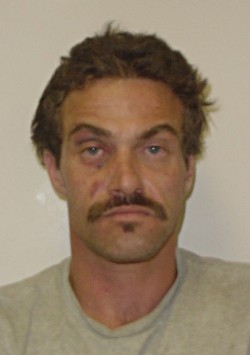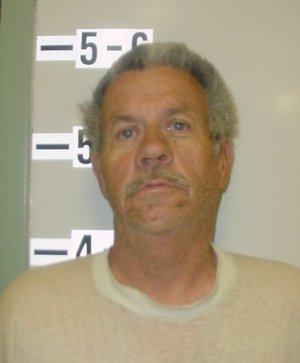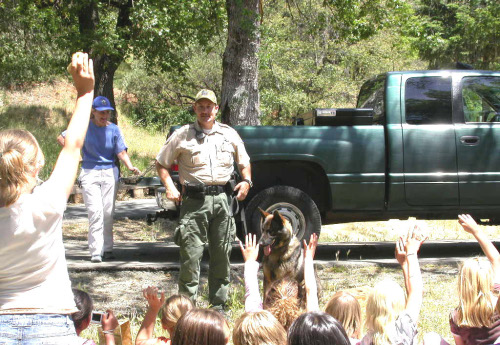
Student stars: Laura Benavides and Kyle Coleman found out Tuesday that they'll each receive a $20,000 scholarship from the Horatio Alger National Scholarship Program. The program places special emphasis on supporting young people who have overcome adversity, are committed to continuing their education and serving their communities. Photo by Elizabeth Larson.
UPPER LAKE – Two very special young people received an incredible piece of news this week – they had each been chosen out of thousands of applicants nationwide to receive $20,000 scholarships to help fund their college education.
Kyle Coleman, 17, of Upper Lake, and Laura Benavides, 18, of Nice, received word Tuesday that they were among 105 recipients of the scholarships, offered by the Horatio Alger National Scholarship Program.
Carrie Blewitt, spokesperson for the awards program, said about 33,000 students from across the United States applied this year for the scholarships, which have been offered since 1984.
“These are the cream of the crop,” Blewitt said of the winners.
Karen Riordan, a counselor at Upper Lake High School – where both Coleman and Benavides are in their senior year – called the news “phenomenal.” Riordan said it's the first time Upper Lake High students have received nationwide scholarships.
Upper Lake High is one of three high schools nationwide – including John Johnson High School in Roseville, Minn., and Itawamba Agricultural High School in Fulton, Miss. – to have more than one recipient of this year's scholarships. Blewitt called the achievement of having more than one student per school “not that common.”
Benavides and Coleman are among seven Californians included on this year's roster of distinguished students.
Blewitt said all of the scholarship recipients will be welcomed to a three-day conference in Washington, DC from April 2 through 4. During the all-expenses-paid trip they will accept their scholarships, do a little sightseeing and take part in ceremonies.
“It's a packed three days,” said Blewitt.
One of the ceremonies will take place at the US Supreme Court, led by Justice Clarence Thomas, one of the members of the Horatio Alger Association of Distinguished Americans, whose membership also includes Maya Angelou, Hank Aaron, Wayne Gretzky, Ross Perot and Colin Powell.
A Saturday morning scholars breakfast, held on April 4, will offer the students a chance to share their stories, “which is pretty moving,” said Blewitt.
The students say their parents were very happy about the scholarships. So were there friends, and Riordan said she “squeezed Laura to death” at the news. Riordan added the school is very pleased and proud of the two.
Benavides said one of her friends helpfully offered to beat her with a stick if she didn't take the scholarship and make the most out of it.
Both students said they found out about the scholarship the old-fashioned way – on the counseling bulletin board's list of available scholarships.
Named for the author Horatio Alger Jr., who wrote stories about people overcoming adversity through tireless work and persistence, the Horatio Alger Association of Distinguished Americans Inc.'s national scholarship program honors young people who have shown the same willingness to face tough times and overcome them.
Emphasis also is placed on “critical” financial need – preference is given to students from homes where the adjusted gross income is $50,000 a year or less – involvement in community and co-curricular activities, and a strong commitment to pursue a bachelor's degree at an accredited US college or university.
One of the largest college financial aid programs in the country, the Horatio Alger National Scholarship Program also seeks to recognize students who have a commitment to use their college degrees in service to others.
The lengthy online application asked many personal questions about the students' background. Benavides said it was important to be willing to share those experiences.
The determination to succeed
Despite their youth, both Benavides and Coleman have faced and overcome challenging situations. And, in both cases, it's the power of love and encouragement from family members that have helped them succeed.
Benavides, who has a 3.59 grade point average and is Upper Lake High's Webmaster, is one of eight children. She and her twin sister, Lisa, along with a younger brother and sister, all live with her mother, Angela Robertson, and with her grandparents, Gene and Kathy Robertson. She also has four younger siblings under the age of 10 who live with her father in Reno, Nev.
Originally from Reno, she said abuse and drugs were issues for her family, which at one point lived in a poor part of town. “It pushed me to try harder.”
But she credits her mother and grandparents with helping her to stay on the right track and encouraging her to think big.
In particular, she said her “papa” isn't afraid to tell her when she's being dumb or when she's doing a good job. “He's been through a lot, too,” she said.
“There's never, ever been a time in my life when my papa and nana haven't been there to support us,” she added.
“We're so proud of her,” said Gene Robertson.
The Robertson have raised six children and now are helping their daughter raise their four grandchildren. Gene Robertson said he thinks his straight talk approach, mixed with love, has helped Benavides and her siblings.
“She's always worked really hard at everything she's done, so it's been easy to try and steer her in the right direction,” he said.
Robertson said his granddaughter is constantly trying to learn and increase her knowledge. “That's amazing to me, to watch her learn.”
He said Laura and her twin sister, Lisa, are “as different as night and day.” Laura Benavides has in the past been involved in the school's famed Academic Decathlon team along with band, with science and English being her favorite topics, while Lisa – also is an A student – is an athlete, playing basketball, softball and volleyball.
Coleman's story also has elements of struggle, plus an added measure of heartbreak.
He was just 11 years old when his mother, Diedre Coleman, was murdered in July 2002. He mentions the tragedy briefly in discussing the obstacles he's had to overcome.
Nor has he let a serious injury suffered in his freshman year slow him down. He was in wood shop class when an accident severed three of the fingers on his left hand. Then his 27-year-old half-brother, Nathan, recently passed away.
Coleman said his dad, Bill Coleman, and brother Wade have helped him get through the hard times.
Bill Coleman said the teen has grown through his problems. “He's a tough little man.”
The baby of the family, Kyle Coleman has two older brothers, Eric and Wade, and a sister, Amber.
Kyle Coleman always has been driven, and is just as good at academics as athletics, said his proud dad.
“He's just unbelievable,” said Bill Coleman.
Kyle Coleman, who has a 4.05 grade point average, will be this year's valedictorian, said his father.
Besides being a great student who is particularly fond of math and history, Coleman is an all-around athlete. He plays basketball and golf, and played football for three years before deciding this year to give cross-country running a try, improving his times by the end of the year.
Riordan teases that he took on cross-country so he could outrun the girls.
He's also a member of the Academic Decathlon team, which Bill Coleman accompanied as a chaperone on a trip to Egypt in late November. The Lake County Academic Decathlon competition will be held Feb. 7.
Achievement is clearly on both students' minds. Riordan said both are very driven with the ambition to succeed.
Benavides has applied to several schools, but her top picks are the University of Nevada, Reno – which already has accepted her – and the University of California, Davis. She wants to study microbiology with a view to a medical career.
Coleman expects to have word about his acceptance any time from his two top picks, both University of California schools – Santa Barbara and San Diego. He's interested in computer engineering, but as for a prospective career, he said, “I haven't found that out yet.”
While their awards are sizable, the $20,000 scholarships both Benavides and Coleman received will be only a small part of the money they'll need to get through the university of their choice. That's due to the ever-increasing costs of higher education that are facing young people.
At the University of Nevada, Reno, Benavides said all expenses for in-state students for a year – including tuition, and room and board – amount to $19,000 and $26,000 for out-of-state students.
The University of California campuses Coleman is eying have total annual expenses of about $25,300, and could top $26,000 if Gov. Arnold Schwarzenegger's proposed tuition hikes for the 2009-10 fiscal year go through.
That means more scholarships are needed for both. They're still in the process of receiving some others, applying and waiting for results.
There's also the April trip to Washington, DC prepare for, which will be Coleman's first experience of the nation's capitol. Benavides visited last year for the first time on an academic trip.
They're both looking forward to the rest of the school year, with college and leaving their families looming just beyond graduation.
Benavides said she is going on a “memory rampage” with her camera, trying to capture as much of it as possible because she knows it will be over soon.
They both have the love of their proud parents, grandparents and siblings to help carry they forward to the next place.
“I hope she's going to go great places in this world,” Gene Robertson said of his granddaughter.
E-mail Elizabeth Larson at elarson@lakeconews.com.
{mos_sb_discuss:2}
















